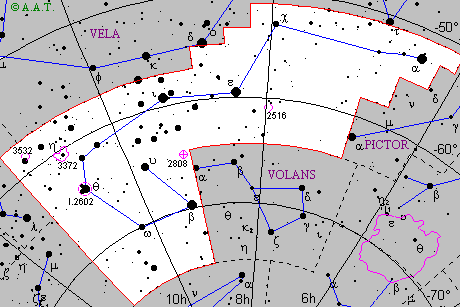 |
 |
| English name | Hull | ||||
|---|---|---|---|---|---|
| Major stars | alpha Carinae | Canopus | magn. -0,7 | RA: 06h 23m 57.17s | Dec: -52° 41' 44.5" |
| beta Carinae | Miaplacidus | magn. 1,7 | RA: 09h 13m 12.14s | Dec: -69° 43' 02.2" | |
| epsilon Carinae | Avior | magn. 1,8 | RA: 08h 22m 30.84s | Dec: -59° 30' 34.3" | |
| theta Carinae | magn. 3,0 | RA: 10h 42m 57.34s | Dec: -64° 23' 39.9" | ||
| iota Carinae | Aspidiske | magn. 2,3 | RA: 09h 17m 05.41s | Dec: -59° 16' 31.1" | |
| ypsilon Carinae | magn. 3,1 | RA: 09h 47m 06.09s | Dec: -65° 04' 18.8" | ||
| SAO 250905 | magn. 3,4 | RA: 10h 17m 04.93s | Dec: -61° 19' 56.3" | ||
| Description | Big constellation of the southern hemisphere, to the southwest of Centaurus. It contains many bright stars, among which Canopous is conspicuous for its magnitude -0,7, that make it the second star of the sky in order of brightness: it is a yellow supergiant, which is 116 light-years away from us. Remarkable are also Miaplacidus, a white-blue star, and ypsilon Carinae, a double star separable with small telescopes.
The constellation of Carina is rich in open stellar clusters: IC 2602, which is around theta Carinae and is similar to the Pleiades (in the constellation of Taurus); NGC 2516, composed by about a hundred of stars among which dominates a red giant of fifth magnitude; and NGC 3532, a great elliptical cluster, formed by around 150 stars, all inferior to sixth magnitude. |
||||
| Mythology and history | The constellation represents the hull of the fifty-oar galley on which Jason and the Argonauts set sail to go to Colchis and take the golden fleece (see the mythology of Aries). The ship construction was work of Argus, from whom it took the name. The history of the adventurous trip to Colchis, through the Bosporus and the Black Sea, is told by the Hellenistic poet Apollonius Rodius in his Argonauts' story. After having taken to the sea, the first standstill of the fifty heroes, is in the Lemno island; the women of the place, who have killed all their husbands, propose to the newcomers to take their place: they don't disdain to spend some days in delightful company, but finally they resume the trip. Then the Argonauts, in proximity of the Bosporus, rescue the blind old man Phineus from the scourge of the Harpies, which steal and dirty his food; in sign of gratitude he foretells the adventures that attend them and the expedients to overcome them. So the ship can overcome the dangerous passage of the Simplegadis, the mobile cliffs that shatter everything passes between them. Arrived in Colchis and taken the golden fleece thanks to the help of Medea, the Argonauts face the return voyage, that however follows a different itinerary. The ship Argus goes up the Danube, then it passes into the Rhone, and from this it comes to the Tyrrhenian Sea; other trials attend the heroes, who revisit the places in which the tradition put the Ulysses' adventures: Circe, the Sirens, Scylla and Carybdis, the Pheacis' island. Finally, after some other adventure, the expedition can make happy return to the Greek coasts. Until the half of the XVIII century the constellation of Carina was united to those of Vela and Puppis, so that they formed the only big constellation of Navis Argo ("ship Argus"). The subdivision was definitely done in 1756 by Nicolas Louis de La Caille. |
||||
 Back to constellations page.
Back to constellations page.